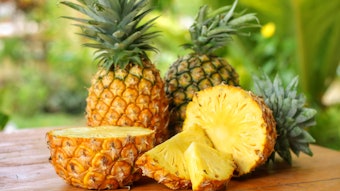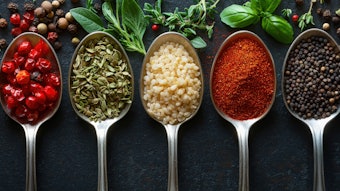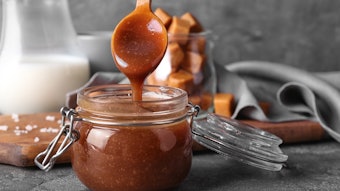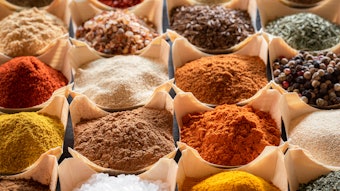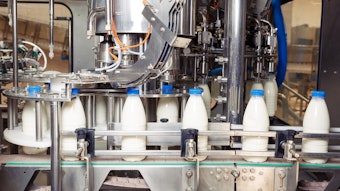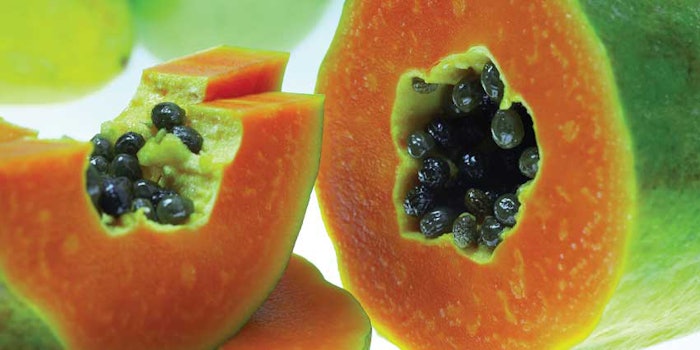
Given the very widespread use of normal butyric acid in flavors, it might seem surprising to focus on iso-butyric acid (FEMA# 2222, CAS# 79-31-2), an ingredient that is only used in a fraction of the volume of its “big brother.”
Both chemicals have a strong cheesy odor, but normal butyric acid has an obviously sharp, cheesy impact than iso-butyric acid. So why am I enthusiastic about iso-butyric acid? My main motivation is the fact that the more subtle profile of iso-butyric acid blends into many fruit flavors more harmoniously than butyric acid. There is a parallel here with the comparison between 2-methyl butyric acid and its two cousins 3-methyl butyric acid and normal valeric acid. The softer, more subtle and complex, character of 2-methyl butyric acid also makes it a better choice for most fruit flavors.
iso-Butyric acid has a predominantly bright, cheesy character but this is shaded by a hint of a vinegary note, similar in some respects to propionic acid. This complex character is especially effective in a wide range of fruit flavors but it is also interesting in many non-fruit flavors, particularly those outside the dairy category. One unexpected property of iso-butyric acid is the fact that it works very well in combination with normal butyric acid. This has some use in dairy flavors, where it can tame some of butyric acid’s aggressive qualities.
Note that the dose rates given throughout this article are the levels suggested for use in flavors intended to be dosed at 0.05% in ready-to-drink beverages or in a simple bouillon.
Berry Flavors
Blackberry: iso-Butyric acid adds a soft, subtle, depth of taste to blackberry flavors and can represent a big improvement on the typical combination of acetic acid and butyric acid in this flavor category. The ideal level of addition in blackberry flavors is around 1,000 ppm.
Blackcurrant: This ingredient is distinctly more useful in authentic style blackcurrant flavors than in the buchu oil driven caricatures. The best level is a little lower, around 500 ppm.
Blueberry: In blueberry flavors, iso-butyric acid works particularly well in combination with 2-methyl butyric acid, which is a phenomenon that can be seen in a number of other fruit flavors. The best use level of iso-butyric acid in blueberry flavors is 1,000 ppm.
Cranberry: The same combination is even more effective in cranberry flavors, but here 2-methyl butyric acid is distinctly dominant and iso-butyric acid is best used at lower levels, around 200 ppm.
Gooseberry: Gooseberry flavors are an interesting challenge. They are quite subtle and this ingredient can play a helpful part in the overall profile at around 600 ppm.
Raspberry: The typical combination of acetic acid and butyric acid is also common in raspberry flavors and iso-butyric acid can improve on this effect at an optimum level of addition of 1,500 ppm.
Strawberry: The same is true of strawberry flavors and in this category the frequent use of 2-methyl butyric acid makes the choice of iso-butyric acid even more attractive. The best level of addition in strawberry flavors is 300 ppm.
Other Fruit Flavors
Apricot: The ideal level of use of iso-butyric acid in apricot flavors varies a little with the type of profile desired. The best level of addition in most fresh apricot flavors is 700 ppm, but dried and very floral apricot flavors can make good use of higher levels, up to 1,500 ppm.
Cherry: This ingredient plays a relatively small role in cherry flavors but can still be helpful at levels of addition in the region of 200 ppm.
Grape: iso-Butyric acid is useful in all categories of grape flavors but the ideal level does vary across the categories. Floral, Muscat and other white grape categories are best served by more moderate levels of addition, around 400 ppm. Concord grape flavors are quite different and can make good use of 800 ppm and more.
Kiwi: Kiwi flavors, even more than gooseberry flavors, are very subtle and are best served by modest levels of iso-butyric acid, in the region of 200 ppm.
Papaya: Papaya flavors, in contrast, are anything but subtle and this ingredient works especially well at quite high levels, around 2,000 ppm.
Peach: Peach flavors offer a close parallel to fresh apricot flavors and the ideal level of iso-butyric acid is the same, 700 ppm.
Brown Flavors
Caramel and Toffee: Different levels of addition work better with different styles of caramel and toffee flavors. A good starting point is 1,000 ppm but highly caramelized flavors can accommodate higher levels.
Cocoa and Chocolate: Different levels are also evident in this category of flavors. Cocoa and dark chocolate flavors can accommodate 600 ppm of iso-butyric acid with ease but milk and white chocolate flavors are better served by levels nearer
200 ppm.
Malt and Malted Milk: 200 ppm of iso-butyric acid has a subtle, but interesting, effect in malt and malted milk flavors, adding depth and authenticity.
Molasses and Brown Sugar: In many instances the dose rates of individual ingredients are significantly higher in molasses flavors than in brown sugar flavors. This is not so evident with iso-butyric acid. The best dose rate in molasses flavors is 500 ppm and in brown sugar flavors, it is only modestly lower at 300 ppm.
Vanilla: This ingredient is only really useful in realistic vanilla bean flavors, where it adds depth and authenticity. The best starting dose rate is 100 ppm.
Savory Flavors
Bacon: A good place to start for bacon flavors is 300 ppm, with dose rates a little higher in very cooked and smoked flavors.
Beef: Low levels, around 200 ppm, are similarly effective in roast beef flavors, rounding out the profile and adding realism.
Chicken: A dose rate of 500 ppm of iso-butyric acid works well in chicken flavors, working particularly effectively in roast chicken flavors.
Ham: Here the effect is subtle, but even at a low level of addition, in the region of 200 ppm, this ingredient is quite useful.
Smoke: The best level in smoke flavors varies considerably, but 400 ppm is a good starting point.
Other Flavors
Cheese: iso-Butyric acid can play a part, often in conjunction with butyric acid, in a wide range of dairy flavors. It is most useful in cheese flavors, typically at around 1,500 ppm.
Beer: In a similar way this ingredient can also be helpful in most fermented flavors, particularly beer flavors, where it can be used at around 1,000 ppm.
Walnut: The effect in all nut flavors is distinctly secondary but 200 ppm can be very helpful in walnut flavors.

